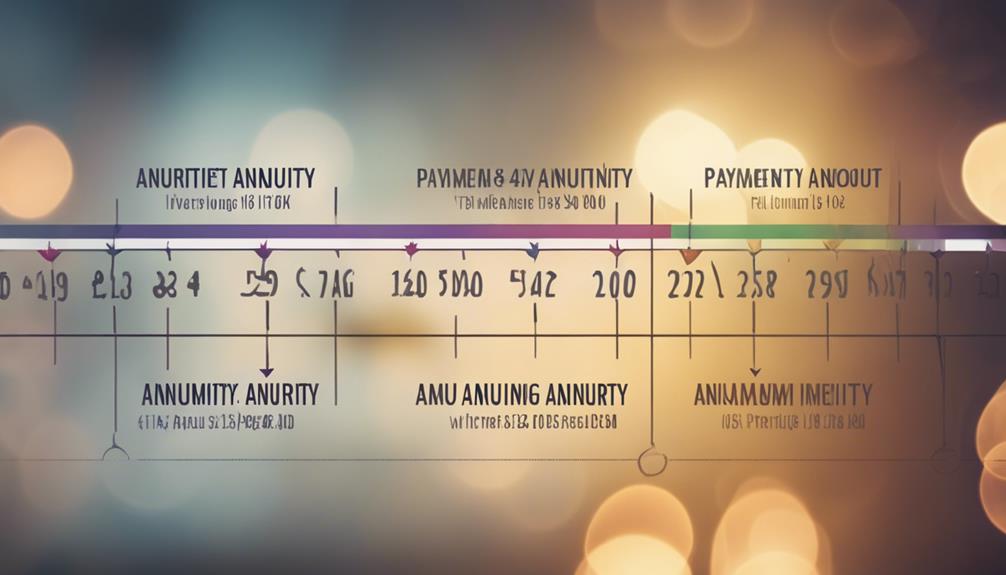Annuities that involve premium payments come in two main options: immediate and deferred. Immediate annuities require a one-time lump-sum premium in exchange for regular income from retirement savings. On the other hand, deferred annuities involve premium payments spread out over time to establish the contract, offering flexible payment frequencies and tax-deferred growth potential. Premium payment options vary from lump sum to series of payments, which can impact future payout amounts and financial security. It is crucial to understand annuity contracts and the implications of premium payments for personalized retirement planning. These premium payments are fundamental to annuities, affecting income levels, growth, and fund availability. They are key to ensuring financial stability for the future.
Key Takeaways
- Immediate annuities require a lump sum premium payment for regular income.
- Deferred annuities involve premium payments over time to establish the contract.
- Series of premium payments accumulate in deferred annuities for future income.
- Premium payments influence timing and structure of annuity payouts.
- Premium payments are essential for funding annuity contracts and determining future income.
Immediate Annuities Premium Payments

Immediate annuities require a single lump-sum premium payment to initiate the immediate receipt of regular income. These premium payments are typically sourced from retirement savings or accumulated assets. By converting the lump sum into a stream of guaranteed income payments, immediate annuities provide a steady income flow, especially when opting for a lifetime income payout option.
While offering financial security, immediate annuities do come with the trade-off of limited liquidity, as the lump-sum premium is committed to generating regular income. The amount of the premium payment influences the subsequent regular income payments, with factors such as age, life expectancy, and prevailing interest rates playing a role in the calculation.
For individuals seeking a stable income post-retirement and willing to trade flexibility for assured income, a single premium immediate annuity can be a suitable option. It is essential to carefully evaluate personal financial goals and risk tolerance before committing to an immediate annuity for consistent and reliable retirement income.
Deferred Annuities Premium Payments

Deferred annuities require premium payments over a period to establish the contract. These payments can be made as either a series of deposits or a lump sum, providing flexibility to the policyholder.
The frequency of payments, flexibility in premium amounts, and the impact on returns are key points that should be taken into account when structuring premium payments for deferred annuities.
Payment Frequency Options
When contemplating premium payment options for deferred annuities, individuals have the flexibility to choose from various frequencies such as monthly, quarterly, semi-annually, or annually.
- Monthly payments allow for more frequent contributions to the annuity.
- Quarterly payments provide a balance between regularity and convenience.
- Semi-annual payments offer a less frequent but more substantial investment approach.
- Annual payments involve a single significant contribution once a year, suited for those preferring long intervals between payments.
These payment frequency options impact the accumulation phase of the annuity, influencing the total amount saved for future income payouts during the annuitization phase. It's important to contemplate how the chosen frequency aligns with your financial goals and cash flow.
Premium Payment Flexibility
Moving on from discussing payment frequency options, the flexibility in premium payments for deferred annuities plays a pivotal role in tailoring financial strategies to individual circumstances. Premium payment flexibility allows for customization based on the amount and frequency of payments, which can vary depending on the annuity contract.
This feature enables individuals to choose how and when premium payments are made, aligning with their unique financial situations. Premium payments are essential for building the cash value and potential future income stream of deferred annuities.
Impact on Returns
Having a direct impact on the eventual annuity payout, the amount and frequency of premium payments in deferred annuities play a pivotal role in shaping the returns on investment. Consider the following points regarding the impact of premium payments on returns in deferred annuities:
- Tax-Deferred Growth: Regular premium payments help grow the account balance tax-deferred, maximizing potential returns.
- Accumulation Potential: The accumulation of funds through periodic contributions enhances the growth potential of the annuity over time.
- Flexible Contributions: Deferred annuities offer flexibility in premium payments, allowing for tailored strategies to optimize returns.
- Regular Payments for Payout: Consistent and timely premium payments contribute significantly to the eventual annuity payout, ensuring a reliable income stream in the future.
Lump Sum Premium Requirement

Lump sum premium annuities are commonly associated with a single, substantial upfront payment made by the annuitant. These annuities do not involve multiple premium payments over time but are funded with a large, one-time payment.
The annuitant can choose between immediate income or deferred income based on the lump sum amount provided. Annuity contracts with lump sum premium requirements outline the terms under which payouts will be received.
This type of annuity offers flexibility to the annuitant in terms of selecting how and when they wish to receive income based on the agreed-upon contract terms. Whether opting for immediate payouts or choosing to defer them to a later date, the upfront payment sets the stage for the annuitant's future financial security.
Understanding the implications of lump sum premium annuities and the options available within annuity contracts is essential for individuals planning for retirement.
Series of Premium Payments

Deferred annuities involving a series of premium payments over time serve as a strategic financial tool for individuals seeking long-term income security and growth potential. When considering annuities with a series of premium payments, here are some key points to keep in mind:
- Accumulation: Premium payments made into deferred annuities accumulate and grow tax-deferred, allowing for potential growth over time.
- Income Payments: Typically, these annuities start making income payments after the investor reaches the age of 59½, providing a source of income in retirement.
- Fixed vs. Variable: Fixed annuities offer a guaranteed interest rate, providing stability, while variable annuities offer a range of investment options, allowing for more flexibility and potential higher returns.
- Investment Options: Understanding the investment options available within deferred annuities is paramount when selecting the right annuity to align with your financial goals. Evaluating risk tolerance and investment objectives is crucial when choosing between fixed and variable annuities.
Premium Payments for Payout Timing

Premium payments play an essential role in determining the timing and structure of payouts for annuities. In the case of deferred annuities, premium payments are made during the accumulation phase before payouts commence. These payments can be made either in a lump sum or through a series of contributions over time.
On the other hand, immediate annuities are funded with a single lump sum premium, providing for immediate payouts. The timing and structure of payouts for annuities are influenced by the premium payments made. The chosen payout timing and structure can vary, impacting how and when the eventual payout amounts are received.
Therefore, understanding the relationship between premium payments and payout timing is important for individuals considering annuities as part of their retirement planning strategy. By carefully planning and selecting the right premium payment options, individuals can make sure that their annuities align with their financial goals and retirement needs.
Funding Annuities Through Premiums

To establish a solid financial foundation for annuities, individuals must make regular premium payments in order to secure the chosen type of annuity and its associated benefits. When funding annuities through premiums, consider the following:
- Fixed Annuities: Require premium payments to fund the contract and guarantee a set interest rate, providing stability in returns over time.
- Variable Annuities: Also necessitate premium payments, with the funds typically being invested in mutual funds, offering the potential for higher returns but with greater risk.
- Equity-Indexed Annuities: Need premium payments to credit interest based on a stock index's performance, combining elements of both fixed and variable annuities.
- Market-Value-Adjusted Annuities: Involve premium payments to provide flexibility and potential growth, adjusting the contract's value based on market conditions, offering a dynamic approach to annuity investments.
Determining Future Payout Amounts

When considering annuities, the determination of future payout amounts is greatly influenced by the size and frequency of the premium payments made by the policyholder. In the case of deferred annuities, where funds accumulate during the accumulation phase before payouts begin, the amount of premium payments plays a vital role in shaping the future payout amounts.
Deferred annuities offer the flexibility of multiple premium payments, impacting the final payout value. Policyholders can choose to make premium payments as a lump sum or through regular contributions, further affecting the future payouts they will receive.
The policyholder's decisions regarding the size and frequency of premium payments are key factors that directly influence the eventual payout amounts they will receive from the annuity. It is essential for individuals to carefully consider their premium payment strategy to make sure that they achieve their desired financial goals during retirement.
Importance of Premium Payments in Annuities

The significance of timely and strategic financial contributions in annuities cannot be overstated. Premium payments play a vital role in the functioning of annuities, whether they are deferred or immediate. Here are four key reasons highlighting the importance of premium payments in annuities:
- Contract Funding: Premium payments are essential for funding the annuity contract, guaranteeing there are sufficient funds to support future income payouts or lump sum disbursements.
- Future Income: The amount of premium payments made directly impacts the amount of future income payments the annuitant will receive. Higher premium contributions often result in larger income streams.
- Annuity Growth: Regular and consistent premium payments contribute to the growth of the annuity over time, potentially increasing the overall payout amount.
- Fund Availability: Premium payments ensure the availability of funds for future income needs, providing financial security and stability for the annuitant. The frequency and consistency of premium payments are critical for maintaining the annuity's financial health.
Frequently Asked Questions
Which of These Annuities Require Premium Payments?
Premium payments are an essential aspect of annuities, serving as the financial contributions that fund the contract and determine future payout amounts.
Annuities that provide guaranteed income streams typically require premium payments to secure future payouts. Whether through a single lump sum or periodic contributions, premium payments are vital in both fixed and variable annuities.
They are a critical element in ensuring financial security and stability for annuitants in retirement.
Do You Pay Premiums on Annuities?
Annuities typically require premium payments, which are essential to fund the annuity contract and accumulate funds for future income payouts. These payments vary based on the type of annuity and payment schedule chosen.
Making regular premium payments is vital to building the value and benefits of the annuity over time. It is important to understand the terms of the annuity contract and the impact of premium payments on your financial future.
What Type of Annuity Is Purchased With a Single Premium Payment?
A single premium annuity is purchased with a lump sum payment upfront and can offer immediate or deferred income options.
These annuities provide a guaranteed income stream for a specified period or for life, making them suitable for individuals with a significant amount of money to invest at once.
Single premium annuities can be a strategic option for those looking to secure their financial future with a one-time investment.
Which Type of Annuity Stops Payment on the First Death?
An annuity that stops payments on the first death of the annuitant is known as a 'Life Only' annuity. This type of annuity provides income solely for the lifetime of the annuitant, with no provisions for continuing payments to a surviving spouse or beneficiary after the annuitant's passing.
While the 'Life Only' option offers higher payouts, it is important to evaluate its implications on financial planning for dependents or beneficiaries.
Do All Annuities Require Premium Payments?
Yes, all annuities require premium payments, including the benefits of fixed annuities. These payments can be made as a lump sum or through regular installments. By making premium payments, individuals can secure a guaranteed income stream for their retirement.
Conclusion
In summary, premium payments are necessary for both immediate and deferred annuities, with options for lump sum or series of payments. These payments are vital in determining future payout amounts and ensuring financial security in retirement.
For instance, a hypothetical scenario could involve a retiree choosing to fund a deferred annuity with a series of premium payments to secure a steady income stream later in life.
By understanding the importance of premium payments, individuals can make informed decisions to support their financial future.










